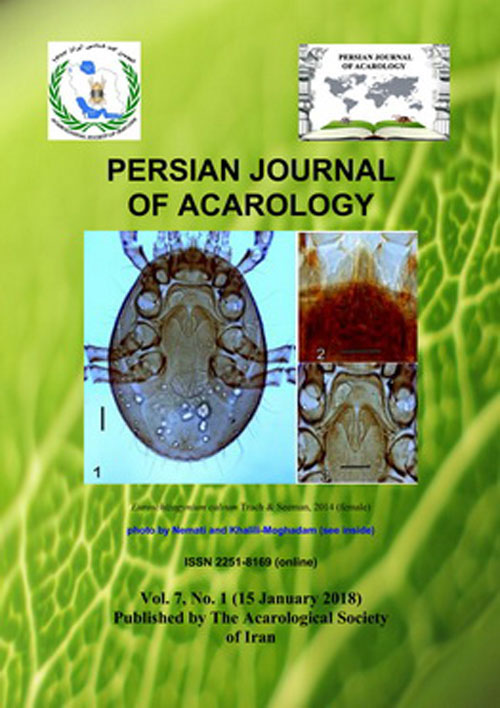فهرست مطالب

Persian Journal of Acarology
Volume:7 Issue: 2, Spring 2018
- تاریخ انتشار: 1397/02/01
- تعداد عناوین: 7
-
-
Pages 105-113Two genera and four species of myrmecophilous microdispid mites (Acari: eterostigmata: Microdispidae), associated with various ants (Hymenoptera: Formicidae), are recorded from northwestern Iran: Unguidispus japonicus Kurosa, 1979 phoretic on Lasius obscuratus Stitz, 1930, Caesarodispus samsinaki (Mahunka, 1967) on Formica sp., C. modestus (Berlese, 1903) on Messor sp. and C. minutus Sevastianov, 1981 on Tetramorium sp. The species C. samsinaki and U. japonicus are recorded for mite fauna of Iran for the first time. A new ant host record is also documented for U. japonicas. The world distributions of the recorded mites are presented. Moreover, all Iranian microdispid records, along with their host/habitat are reviewed and a key to their genera and species is provided.Keywords: Formica, Formicidae, Lasius, Messor, phoretic mites, Tetramorium
-
Pages 115-191The present catalogue deals with the results of a survey carried out on available literature consisted of collected and identified mesostigmatic mites associated with different kinds of host/habitats in Iran. Some family, genera, and species of mesostigmatic mites of Iran which were not included in the checklist provided by Kazemi and Rajaei, 2013 as well as their distribution data are presented. Overall, a total of 371 species out of 127 genera belonging to 39 families were listed in the present paper. Consequently, by considering Phytoseiidae family, the list of mesostigmatic mites reported from different parts of Iran was increased into 47 families, 172 genera and 620 species. It is also worth mentioning that Ololaelaps gamagarensis Jordaan & Loots was considered as junior synonym of O. mooiensis Ryke and Pseudoparasitus talebii Nemati, Malekshahkoohi & Afshari, was considered as junior synonym of P. hajiqanbari Kazemi.Keywords: Checklist, distribution, Ololaelaps mooiensis, Pseudoparasitus hajiqanbari, synonymy
-
Pages 116-191Prasadiseius achlora (Prasad, 1972) is redescribed based on photomicrographs of a paratype female specimen. Chaetotaxy of the idiosoma and genua and tibia is given, including corrections to the original description. Photomicrographs of the female's insemination system are provided showing that the species of Prasadiseius probably have a "laelapid-type" but do not show the sacculus as it is apparently not chitinized.Keywords: Chaetotaxy of genu, tibia, Katydiseiinae, setae r3, Z5, sperm access system, sphingid mite
-
Pages 193-201Two-spotted spider mite, Tetranychus urticae Koch is a serious pest of different crops over the world. Different strategies are used to regulate the population of this mite. To this end, as a first step, a population growth model has been developed for describing the dynamics of T. urticae population growth. In this regard, the population abundance of T. urticae was estimated weekly from 29 June to 29 September 2016 at two bean fields, each field was planted with Goli and Akhtar cultivars, separately. During each sampling period in each field, 30 plants were randomly chosen and a leaf was selected as a sample unit from the middle of a plant, then a simple population growth model was constructed for T. urticae on two bean cultivars. The result showed that T. urticae had a distinct seasonal pattern of abundance but differed between two cultivars. A logistic growth model was developed based on relationship between the cumulative density of T. urticae and time (day) and demonstrated high prediction capability for T. urticae population on Goli (R2 = 0.99) and Akhtar (R2 = 0.99) cultivars. According to the logistic equation, carrying capacity was recorded 463.9 ± 9.73 (mite/leaf) and 59.67 ± 8.72 (mite/leaf) on Goli and Akhtar cultivars, respectively. Furthermore, it has been shown that the logistic growth model can be used to make population predictions. The model parameters estimated for two different cultivars, providing a new mathematical tool for ecologists to predict two-spotted spider mite outbreaks, and ultimately to develop effective two-spotted spider mite control strategies.Keywords: Bean cultivars, carrying capacity, logistic equation, population dynamics, two-spotted spider mite
-
Pages 203-208The aim of this study was to evaluate acaricidal activity of Melia azedarach L. ripe fruit extract against Dermanyssus gallinae (De Geer, 1778) under laboratory conditions. For this purpose, hexanic ripe fruit extract of this tree at concentrations 0.25, 0.5, 1, 3, 5 and 10% were prepared with acetone as solvent and treatment groups exposed to these concentrations using Petri dish residual film bioassay method. The positive control was carbaryl while negative control was acetone. The bioassay was repeated five times. The mortality rate of mites in treatment and control groups were assessed 24 h post exposure. All treatment groups showed significantly higher mortality compared to the negative control group (PKeywords: Acaricidal activity, biopesticide, natural acaricide, Persian lilac, poultry red mite
-
Pages 209-216Otobius megnini is a tick species which it's larvae and nymphs feed deep in the external ear canal of a variety of ungulates. In this study, twelve adult and four nymph specimens were collected from cattle hosts in Sistan and Baluchestan, and Hamedan Provinces. The specimens were identified using morphological key and the datawas confirmed by molecular assays. In the present study, we could find O. megnini in tick fauna of Iran with new hosts for this species.Keywords: Cattle, molecular assay, COI, soft tick, spinose ear tick
-
Pages 217-220Herein, two species of the genus Halolaelaps Berlese & Trouessart, including H. saproincisus Hirschmann & Götz and H. curvisetosus (Leitner), are reported for the first time from Iran.Keywords: Gamasina, Rhodacaroidea, phoretic deutonymphs, soil-dwelling mite

